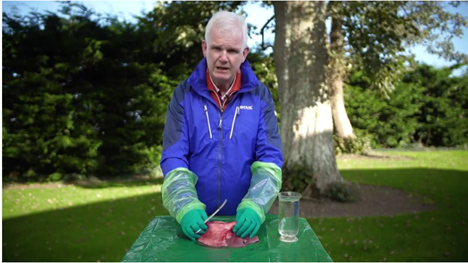The number one topic when it comes to calf health is respiratory diseases. Why cattle in particular are so susceptible to respiratory diseases is mainly due to the relatively small lungs in contrast to the animal's body. In order to achieve the genetically determined maximum performance, the lungs must be strongly ventilated with oxygen-rich air. This results in a high risk of contamination with air containing pathogens.
Also, compared to other animals, the alveoli of the bovine lung are only poorly supplied with blood vessels, so that the gas exchange capacity is low or the bovine has to breathe more in order to achieve a certain performance. Another difference in the structure of the bovine lung is responsible for its particular susceptibility. This is because it is divided into individual segments by connective tissue. In the event of an infection, the pathogens involved can rarely overcome these hurdles and favour an inflammation. In addition, lung growth in calves does not begin until four weeks after birth and does not end until after one year; this immaturity of the lungs also makes calves particularly susceptible.
Since it seems that the bovine lung system cannot function at all, it is obvious to protect the animals with a vaccination against respiratory diseases. But which vaccination makes sense here? Various pathogens can trigger the disease pattern of BRD (see table below), some can also lead to independent diseases with severe economic consequences.
The most important pathogens in the complex of bovine respiratory diseases:
Viruses | Bacteria |
Bovine respiratory syncytial virus (BRSV) can also cause specific respiratory diseases alone (monocausal) | Mannheimia haemolytica |
Bovine herpes virus 1 (BHV 1) (IBR/IPV) can also cause specific respiratory diseases alone (monocausal) | Pasteurella multocida |
Parainfluenza 3 virus (PI3) | Histophilus somni |
REO virus | Mycoplasma (M.) bovis, M. dispa |
Rhino virus 1 and 2 | Chlamydophila spp. |
Bovine adenovirus (BAV) | Trueperella pyrogenes |
Bovine corona virus (BCV) |
|
Bovine viral diarrhoea / mucosal disease virus (BVD / MD) mainly immunosuppression |
|
Exner, U. und Schneider, J. (2012): Atemwegserkrankungen bei Rindern. Broschüre. Boehringer Ingelheim Vetmedica GmbH. www.vetmedica.de
The possibilities to counter them seem to be almost as diverse as the number of pathogens. The best solution is a vaccination programme specifically adapted to the problems of the farm. The herd veterinarian can help with the selection of the appropriate vaccine, which must be suitable for the pathogen but also for the time of vaccination or the farm routine. In some cases, a farm-specific vaccine may also be considered.
A possible component of the vaccination programme can include, for example, intranasal vaccination from 10 days of age in order to achieve local protection against bovine respiratory syncytial virus (BRSV) and parainfluenza 3 virus (PI3) directly at the point of entry. Vaccination is easy to apply and provides early protection. Another component can be an injection vaccination, which (> 2 weeks after intranasal vaccination) upgrades the immune response to BRSV and PI3V and provides protection against Mannheimia haemolytica (also against BVDV if needed). Regular herd vaccination every 6 months can then build up strategic herd immunity. This lowers the number of susceptible animals, reduces the spread of the virus and is able to protect the young animals until they are vaccinated (=cocooning).
How a beef farmer in Ireland manages the vaccination of his purchase calves you can read in the good practice report “Using a sourcing and animal health protocol to reduce health and welfare issues on a bull beef fattening unit in Ireland.”
Impact:
- It is possible to obtain a higher price for vaccinated calves. In addition, they may be healthier and gain more weight and thus pay off.
Sources:
- Mahlkow-Nerge, K. (2011): Was bei Rindergrippe hilft. In: Thema: Was Kälber wirklich brauchen. Retrieved 19.04.2022 from AgrarHeute.com https://docplayer.org/27239349-Thema-was-kaelber-wirklich-brauchen.html
- Exner, U. und Schneider, J. (2012): Atemwegserkrankungen bei Rindern. Broschüre. Boehringer Ingelheim Vetmedica GmbH. www.vetmedica.de
- Boehringer Imgelheim. Gemeinsam gegen Atemwegserkrankungen beim Rind. Broschüre. https://www.vetmedica.de/broschuere-atemwege-rind.pdfx
